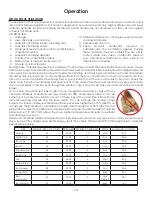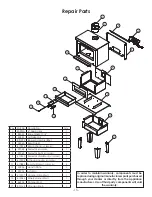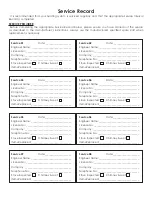
-11-
It is EXTREMELY IMPORTANT to use DRY WOOD only in your wood stove. The wood should have dried for 9 to
15 months, such that the humidity content (in weight) is reduced below 20% of the weight of the log. It is very
important to keep in mind that even if the wood has been cut for one, two or even more years, it is not necessarily
dry, if it has been stored in poor conditions. Under extreme conditions, it may rot instead of drying. This point
cannot be overstressed; the vast majority of the problems related to the operation of a wood stove is caused by
the fact that the wood used was too damp or had dried in poor conditions. These problems can be:
- ignition problems
- creosote build-up causing chimney fires
- low energy yield
- blackened windows
- incomplete log combustion
Smaller pieces of wood will dry faster. All logs exceeding 6” in diameter should be split. The wood should not be
stored directly on the ground. Air should circulate through the cord. A 24” to 48” air space should be left between
each row of logs, which should be placed in the sunniest location possible. The upper layer of wood should be
protected from the elements but not the sides.
OPERATIONAL TIPS
•
Get the appliance hot and establish a good coal bed before adjusting to a low burn rate (this may take 30
minutes or more depending on your wood)
•
Use smaller pieces of wood during start-up and a high burn rate to increase the stove temperature
•
Be considerate of the environment and only burn dry wood
•
Burn small, intense fires instead of large, slow-burning fires when possible
•
Learn your appliance’s operating characteristics to obtain optimum performance
Burning unseasoned wet wood only hurts the stove’s efficiency and leads to accelerated creosote buildup in
your chimney
TESTING YOUR WOOD
•
When the stove is thoroughly warmed, place one piece of split wood (about five inches in diameter) parallel
to the door on the bed of red embers.
•
Keep the air control fully open by pulling on it and close the door. If the piece ignites within 90 seconds from
the time it was placed into the stove, your wood is correctly dried. If ignition takes longer, your wood is damp.
•
If your wood hisses and water or vapor escapes at the ends of the piece, your wood is soaked or freshly cut.
Do not use this wood in your stove. Large amounts of creosote could be deposited in your chimney, creating
potential conditions for a chimney fire.
TAMPER WARNINGS
This wood heater has a manufacturer-set minimum low burn rate that must not be altered. It is against federal
regulations to alter this setting or otherwise operate this wood heater in a manner inconsistent with operating
instructions in this manual.
THE FIRST FIRES
The fresh paint on your stove needs to be cured to preserve its quality. Once the fuel charge is properly ignited,
only burn small fires in your stove for the first four hours of operation. Never open the air control more than
necessary to achieve a medium burn rate. Make sure that there’s enough air circulation while curing the stove.
The odors could be smelled during the 3 or 4 first fires. Never start your stove outside. You will not be able to see
if you are overheating.
IGNITION
After making sure that the stove air intake controls are fully open (completely pull-out towards you), The top-
down method of fire building is recommended for this appliance. After making sure that the stove air intake
controls are fully open (completely pull-out towards you), Place the largest pieces of wood on the bottom, laid
in parallel and close together. Smaller pieces are placed in a second layer, crossways to the first. The third layer
of still smaller pieces are laid crossways to the second, this time with some spaces between. Then the fourth layer
of loose, small kindling and twisted newspaper sheets tops off the pile. Before igniting the paper and kindling
wood, it is recommended that you warm up the chimney. This is done to avoid backdraft problems often due to
CAUTION: Never alter the damper slide or the adjustment range to increase firing for any reason. Doing so
could result in heater damage and will void your warranty.
Summary of Contents for VOGELZANG VG2020
Page 17: ...17 Notes...
Page 18: ...18 Notes...





































